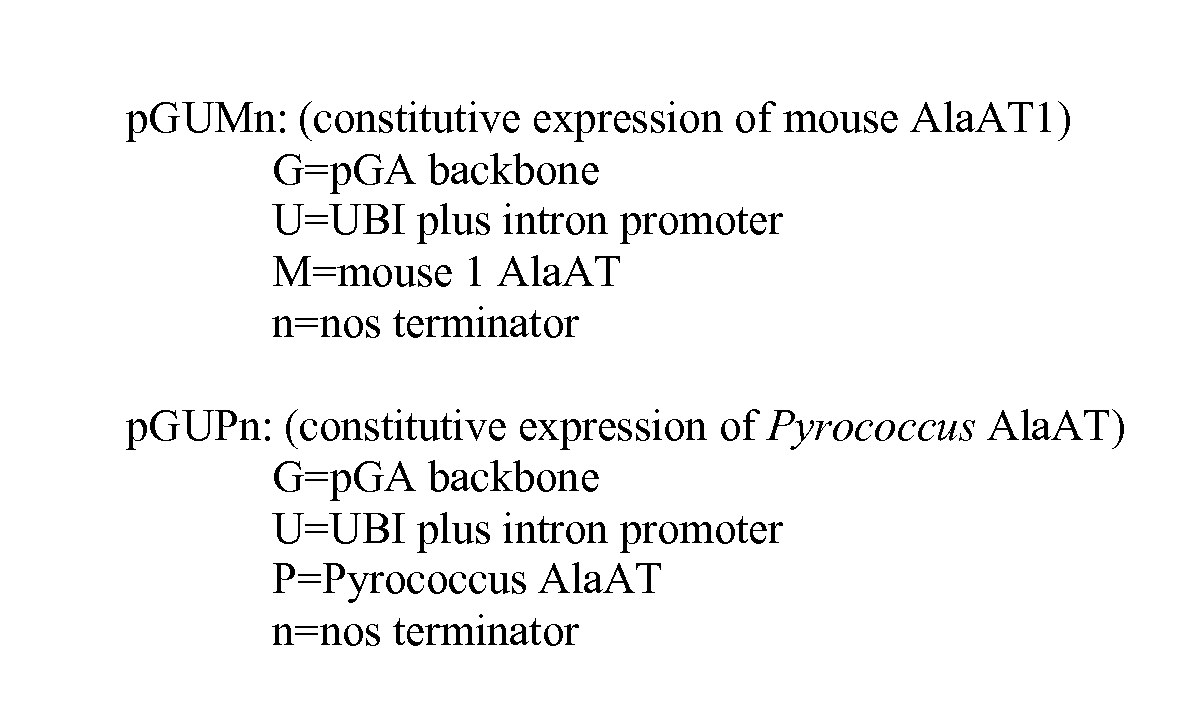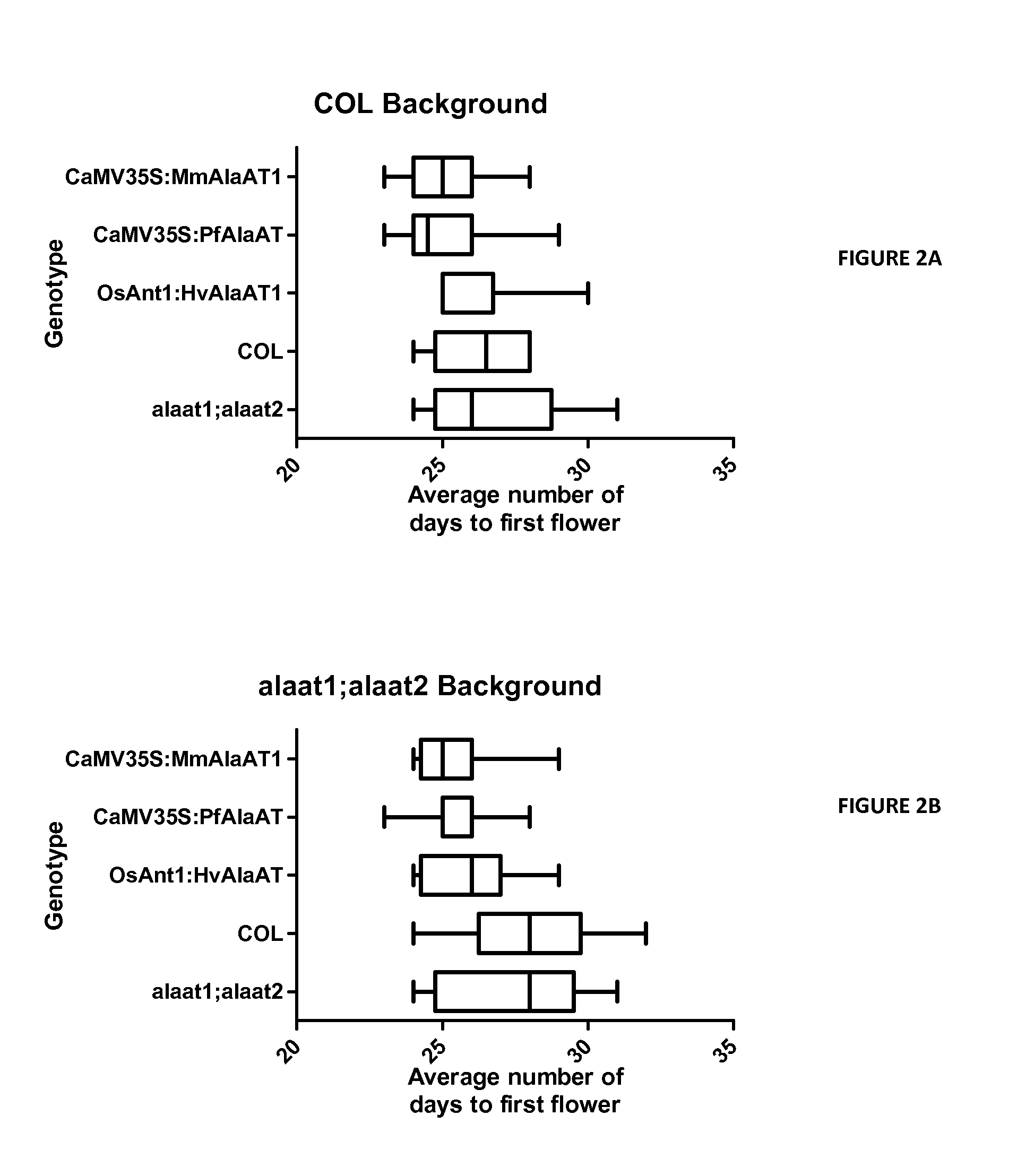Plants having enhanced nitrogen use efficiency and methods of producing same
- Summary
- Abstract
- Description
- Claims
- Application Information
AI Technical Summary
Benefits of technology
Problems solved by technology
Method used
Image
Examples
example 1
[0093]Novel AlaAT gene constructs (CaMV35S::MmAlaAT1;CaMV35S::PfAlaAT; and OsAnt1::HvAlaAT1) were introduced into either the alaat1;2 double knock out (DNK) (FIG. 2B) or the normal genetic background (COL background) (FIG. 2A).
[0094]The novel AlaAT gene constructs reduced the time to flowering in the transgenic Arabidopsis thaliana.
[0095]Furthermore, the introduction of a novel AlaAT gene into either the normal genetic background or the DNK background, under two different conditions (as described above) increases the rate of root growth of the transgenic plant, and this rate changes as the plants get older (see FIGS. 3A and 3B). FIG. 3A illustrates the rate of tap root growth (cm) over 0-5, 5-8, 8-12 and 12-15 DAS with no sucrose added to the medium and 1 mM nitrate as the nitrogen source. FIG. 3B3A illustrates the rate of tap root growth (cm) over 0-5, 5-8, 8-12 and 12-15 DAS with 0.2% sucrose added to the medium and 0.25 mM nitrate as the nitrogen source. The comparison between t...
example 2
[0097]In FIG. 5, wild-type Arabidopsis plants and transgenic Arabidopsis plants over-expressing CaMV35S::MMAlaAT1 were grown on modified ½ MS supplemented with 2.5 mM alanine as the sole nitrogen source. WT and AlaAT over-expressers (OE) were grown on the same plate. OE lines are a COL background over-expressing MmAlaAT1 (35S:MmAlaAT1 line 2-1-7).
[0098]In FIG. 6, wild-type Arabidopsis plants and transgenic Arabidopsis plants over-expressing CaMV35S::PfAlaAT were grown on modified ½ MS supplemented with 2.5 mM glutamate as the sole nitrogen source. WT and AlaAT over-expressers (OE) were grown on the same plate. OE lines are a COL background over-expressing PfAlaAT (35S:PfAlaAT line 4-1-2).
[0099]FIGS. 5 and 6 demonstrate that when a novel AlaAT gene is driven by the correct promoter, it has a significant effect on root growth, root length and overall root branching.
example 3
[0100]In FIG. 7, wild-type Arabidopsis plants and transgenic Arabidopsis plants over-expressing novel AlaAT genes (OsAnt1::HvAlaAT; CaMV35S::HvAlaAT; CaMV35S::MMAlaAT1; CaMV35S::MMAlaAT2; and CaMV35S::PfAlaAT) in a COL background were grown on modified ½ MS supplemented with 0.25 mM KNO3− as the sole nitrogen source. The change in tap root growth (cm) between 0-5 DAS was measured.
[0101]In FIG. 8, wild-type Arabidopsis plants and transgenic Arabidopsis plants over-expressing novel AlaAT genes (OsAnt1::HvAlaAT; CaMV35S::HvAlaAT; CaMV35S::MMAlaAT1; CaMV35S::MMAlaAT2; and CaMV35S::PfAlaAT) in a COL background were grown on modified ½ MS supplemented with 0.25 mM KNO3− as the sole nitrogen source. The change in tap root growth (cm) between 5-8 DAS was measured.
[0102]In FIG. 9, wild-type Arabidopsis plants and transgenic Arabidopsis plants over-expressing novel AlaAT genes (OsAnt1::HvAlaAT; CaMV35S::HvAlaAT; CaMV35S::MMAlaAT1; CaMV35S::MMAlaAT2; and CaMV35S::PfAlaAT) in a COL background w...
PUM
| Property | Measurement | Unit |
|---|---|---|
| Fraction | aaaaa | aaaaa |
| Efficiency | aaaaa | aaaaa |
Abstract
Description
Claims
Application Information
 Login to View More
Login to View More - R&D
- Intellectual Property
- Life Sciences
- Materials
- Tech Scout
- Unparalleled Data Quality
- Higher Quality Content
- 60% Fewer Hallucinations
Browse by: Latest US Patents, China's latest patents, Technical Efficacy Thesaurus, Application Domain, Technology Topic, Popular Technical Reports.
© 2025 PatSnap. All rights reserved.Legal|Privacy policy|Modern Slavery Act Transparency Statement|Sitemap|About US| Contact US: help@patsnap.com



